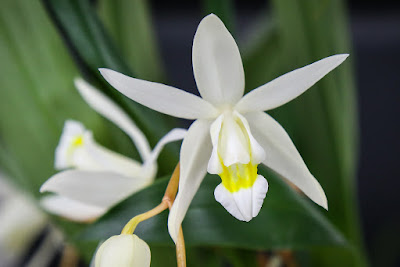Coelogyne glandulosa is found in the south of India, where it grows both epiphytes in trees, and lithophyte on rocks in lower montane forests at an altitude of 1000 to 2000 meters above sea level...
Coelogyne glandulosa also called as The Coelogyne With Glands, Coelogyne glandulosa var bournei, Coelogyne glandulosa var. sathyanarayanae, Coelogyne nervosa, Pleione glandulosa, is a species of the genus Coelogyne. This species was described by John Lindley in 1853.
IDENTIFY COELOGYNE GLANDULOSA ORCHID PLANT
Coelogyne glandulosa is found in the south of India, where it grows both epiphytes in trees, and lithophyte on rocks in lower montane forests at an altitude of 1000 to 2000 meters above sea level.
It is a small sized, cool growing epiphyte or lithophyte with close set, ovoid, slightly curved with age, ridged, furrowed, 3-8 cm long and 1.5 cm wide pseudobulbs enveloped basally by a few coriaceous sheaths and carrying 2, elliptic-oblong to oblong-lanceolate, acute, plicate, 7 to 11 nerved, undulate, coriaceous, tapering towards the base into the petiolate base, 9 to 20 cm long and 2 to 5 cm wide leaves.
The Coelogyne With Glands blooms in the spring on a erect, 20 cm long, 2 to 8 flowered inflorescence arising on a newly emerging pseudobulb with persistent floral bracts and simultaneously opening flowers. The flowers are white, with a small fraction of yellow on the lip. Tepals oval-elliptical shape, with pointed tips, about 3 cm in length and 1.4 cm in width. Behind the sepals are visible light veins. The lip is triple, 2 cm long and 2 cm wide. Lateral parts of the lip rounded, on both sides cover the column, but do not close above it. The front part of the lip resembles a half-ellipse in its shape. The column is slightly curved.
COELOGYNE GLANDULOSA ORCHID PLANT CARE AND CULTURE
Cultural information should only be used as a guide, and should be to be adapted to suit you. Your physical location; where you grow your plants, how much time you have to devote to their care, and many other factors, will need to be taken into account. Only then can you decide on the cultural methods that best suit you and your plants.
Light:
Coelogyne glandulosa loves the bright sun without access to direct sunlight, so during the hot midday sun on the windows of the southern orientation and the hot evening sun on the western windows, the orchid must be placed behind the curtain or into the shade of other plants. Otherwise, it may get sunburn. The color of the plant is best indicated by the color of the plant, if the leaves acquire a yellow-green hue or are covered with yellow or brown marble spots, the orchid should be rearranged to a darker place.
Temperature:
This type of orchid refers to a moderately cold temperature regime: Summer temperature is 18-20 ° C in the daytime and 10-14 ° C at night; Winter temperature is 15 ° C during the day and 10 ° C at night. For the successful cultivation at home, it is necessary that the night temperature of the content is always 6-8 ° C lower than the daytime temperature.
Humidity:
The Coelogyne With Glands needs the humidity level of 60% or more. Too dry air negatively affects the growth and development of plants, most often expressed in the yellowing of leaves and in the slower development of new shoots. When growing this type of orchid is strongly recommended to use air humidifiers.
Substrate, growing media and repotting:
Coelogyne glandulosa is grow in pots or pendant wooden trellis boxes. The substrate must be very well breathable, therefore in its quality the mixture of large pieces of bark of coniferous trees with polystyrene and fern Osmund is the best.
At the transplant this species reacts quite negatively, so transplanting is recommended only when it is really necessary. For example, if the plant has grown so much that the pot is already narrow, or in cases of salinization or condensation of the substrate, etc. The best time for transplant is the period immediately after flowering. In view of the fact that the development of peduncles occurs simultaneously with the development of new shoots, it is highly recommended not to transplant an orchid in the spring, since it will not bloom after that.
Watering:
During the period of new growth, this orchid needs frequent and abundant watering. Excess water during watering should flow freely out of the pot, as the stagnation of water both inside the pot and in its pan can very quickly lead to decay of the roots and the lower part of the plant. The substrate between waterings should dry well.
Fertilizer:
During the new growth period, this plant is fertilized for every third watering in the usual fertilizer concentration indicated on the package.
Rest period:
To stimulate flowering, Coelogyne glandulosa needs a clearly defined rest period. In winter, the orchids contain much drier and colder than usual, and do not fertilize. The temperature should be 15 ° C during the day, and 10 ° C at night. From watering, you should either refuse completely, or replace it with an easy spraying of the substrate and perform this procedure no more often than once in 4-5 weeks. After the appearance of new shoots, the rest period ends: the watering of the orchid resumes in the usual volume, and the overall temperature of the contents rises.















COMMENTS